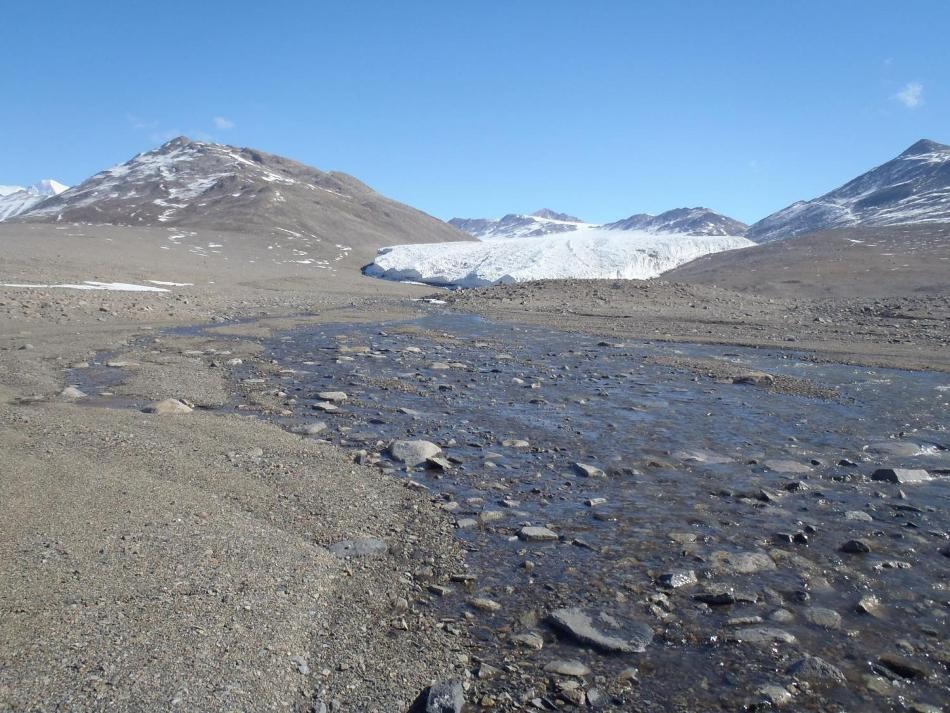Feb 4 2019
CU Boulder researchers have found a promising solution to a longstanding mystery about the chemistry of streamflow in one of the coldest, driest regions on Earth, which may have wide implications for water quality and watersheds worldwide.
 A stream in the McMurdo Dry Valleys, Antarctica. (Image credit: Chris Jaros)
A stream in the McMurdo Dry Valleys, Antarctica. (Image credit: Chris Jaros)
The new research carried out in Antarctica’s arid McMurdo Dry Valleys (MDV) region investigated the almost omnipresent phenomenon in which streams, irrespective of their flow rate, tend to maintain an extremely steady concentration of dissolved minerals in all climates as they flow through the landscape. Simply put, moving water maintains its chemical composition irrespective of whether it’flowing slow or fast.
The dry and pure conditions in Antarctica provide an efficient—although far-flung—natural laboratory to check why it occurs.
The MDV region provides ideal hydrological study conditions. Here, we only have one source of water—glacial melt—and no deep groundwater, with permafrost acting as a physical barrier for the stream. By limiting the number of variables, we can learn a great deal.
Adam Wlostowski, Postdoctoral Researcher, Institute for Arctic and Alpine Research, CU Boulder.
Adam Wlostowski is also the lead author of the study
The study, described in the journal Geophysical Research Letters, investigated seven distinct streams in the Taylor Valley, where meltwater flows to ice-covered lake basins within hours or weeks, compared to the Rocky Mountain region where it takes months or years to flow. In this way, Antarctic streams have a valuable small possibility to stagnate in the landscape.
“We expected the water at the stream outlets to look like the water at the head of glacier due to limited interactions with minerals,” Wlostowski said. “And we thought that as the flow went up, the concentration would decrease. That did not turn out to be true. There was little to no variation even with flow change.”
The results indicate that the key mechanism for this streamflow phenomenon is high levels of chemical weathering by which solid minerals dissolve similar to how rock salt dissolves in a puddle of warm water.
These Antarctic polar desert streams host some of the most rapid chemical weathering rates in the world because their beds are made up of fresh sediments that see water for only 6-10 weeks per year. This is another important lesson we have learned about this ecosystem that is transferrable to other parts of the world.
Michael Gooseff, Professor, Department of Civil, Environmental and Architectural Engineering, CU Boulder.
According to Wlostowski, the research highlights the value of long-term data collection, which allows the study of hydrological phenomena. Here, Wlostowski and his colleagues drew on over two decades of streamflow observations gathered by the National Science Foundation’s McMurdo Dry Valleys Long-Term Ecological Research (LTER) Project, which has funded and supported CU Boulder students and faculty for more than two decades.
The new research provides a high-level understanding of how streams behave geochemically and underscores the significance of stream corridors in shaping water quality prior to reaching its destination.
As climate and land use practices change throughout the world, we want to be able to predict how the quality and quantity of river water may change in response. We can apply lessons from these relatively simplified hydrologic systems in Antarctica to temperate watersheds, where the human implications of environmental management may be much higher.
Adam Wlostowski, Postdoctoral Researcher, Institute for Arctic and Alpine Research, CU Boulder.
Diane McKnight of CU Boulder and William Lyons of Ohio State University are the additional co-authors of the work. The funding for the study was provided by the National Science Foundation and the Polar Geospatial Center.